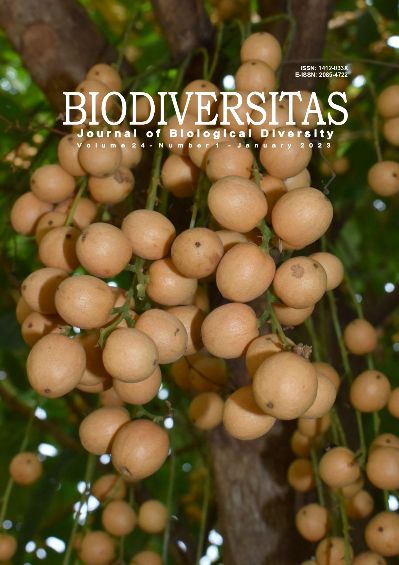Impact of physicochemical parameters of water on the biodiversity of the invertebrate fauna from Echatt Lake, Northeast Algeria
##plugins.themes.bootstrap3.article.main##
Abstract
Abstract. Mounira H, Fatiha BS, Noureddine S. 2023. Impact of physicochemical parameters of water on the biodiversity of the invertebrate fauna from Echatt Lake (Northeast Algeria). Biodiversitas 24: 258-268. Algeria is a case study of biodiversity ignorance. To date, there are neither complete inventories for any taxa nor atlas across the country! Yet, Algeria is of great importance for global biodiversity. The coastal area of Algeria is part of the global biodiversity hotspot which is the Mediterranean perimeter and has several regional red spots of biodiversity. Biodiversity provides raw material resources necessary for living beings' survival and maintaining atmospheric quality, climate regulation, water quality, and soil fertility. In addition, macrobenthic fauna is an important provider of aquatic ecosystems. The present study aimed to determine the biodiversity of the invertebrate community from Echatt Lake (Northeast Algeria) located in a protected area classified by Ramsar in 1983, and to evaluate the impact of anthropogenic activities using water physicochemical parameters on their structure and function. Samples were collected monthly over one year (January 2019-December 2019) at four selected stations, and 2,861 specimens were collected. The identified species (16 species) belong to 9 families: Naucoridae, Hydrophilidae, Notonectidae, Pleidae, Corexidae, Eylaidae, Pionidae, Daphniidae, and Copepoda. Seven physicochemical parameters (temperature, hydrogen potential, electrical conductivity, hydrometric title, alkalimetric title, complete alkalimetric titer, and turbidity) of the water were also determined in each station to evaluate their influence on the abundance and distribution of the invertebrate fauna. The pH and the apparent turbidity influence the invertebrate fauna, while the richness was relatively low at stations 2 and 4, located near anthropogenic sources of pollution. The data obtained permitted us to evaluate the possible impact of anthropogenic activities on the biodiversity of invertebrates.

